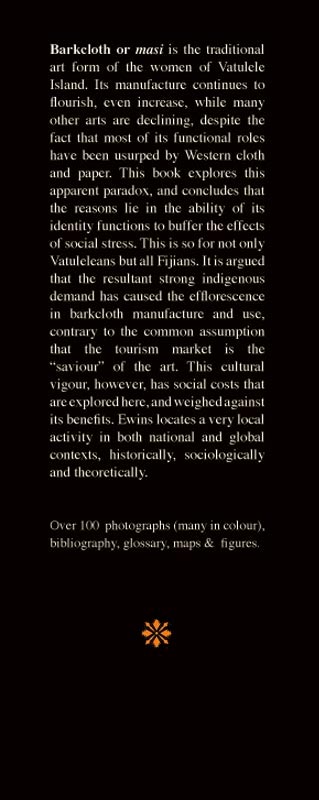Book on Barkcloth & Society by Rod Ewins
[Best viewed at 1344 x 1840 or higher]
My book Staying Fijian, co-published in 2009 by Crawford House Australia and the University of Hawaii Press, has been described in letters written to me, as "user friendly", "inspirational", a "wonderful book", and "one of my valued possessions".
It is now available direct from Just Pacific within Australia for A$30 including postage (RRP A$59.95 + p&p). Customers from outside Australia please contact Just Pacific to request a price, since postal rates may be substantially more than within Australia.
ISBN Australia: 978-1-86333-302-9 ISBN USA: 978-0-8248-3112-7
The book is in hardback, 402 pages, and measures 24.7 x 18.5 cm
Illustrations include over 90 photos (32 in colour and 64 b&w), 4 maps, figures and charts, a Fijian/Vatulelean/English vocabulary, a very extensive bibliography, and index.
Please click to see List of Contents and sample Colour Plate.
The following are the front, back and endflaps of the dustcover
.jpg)
.jpg)

Synopsis:
Bark-cloth or masi (generally called tapa by non-Fijians) is the traditional art of the women of Vatulele. Many other Fijian art forms have declined or disappeared, and barkcloth is no longer produced in some places where it once was. Its utilitarian functions have been almost totally usurped by Western cloth and paper. Despite all this, its production on this small island has increased steadily for over forty years. This book looks at the implications of this apparent paradox.
It is argued that it cannot be explained by its commoditisation as a tourist souvenir, the explanation most commonly advanced. Rather, it is shown to reflect an increasing mobilisation of traditional mechanisms of art and ritual to deal with increasing social and cultural stress, such as shown by Fiji’s recent political upheavals. Barkcloth is shown to have long been one of the most valued of Fijians’ ritual goods, as both ceremonial trappings and for presentations. As the most deeply symbolic of women’s goods, it is seen to play a crucial role in maintaining the gender symmetry that defines Fijian cultural mechanisms.
Finally, such cultural vigour is shown to bring with it its own set of problems. Theere are profound economic implications for Vatulele as social and economic roles become intertwined. Traditional gender roles are challenged as women are at the same time empowered and shackled by becoming the principal breadwinners of the entire community. There are also ecological impacts with intensive cultivation and forest clearance, exacerbated by the threat of climate- and sealevel-change. Ultimately, however, it is presented as a strong unifying force for a small community facing many local and global challenges.
This book places a very local activity in a global context, both sociologically and historically. However, it is more than just an academic study, and gives a very personal and detailed insight into the functioning of a small island community as it deals with change by utilising tradition. It includes over 90 photographs, both historical and from the author's own fieldwork, of barkcloth production and use, and relevant ritual.
SEE CONTENTS PAGES OF BOOK
